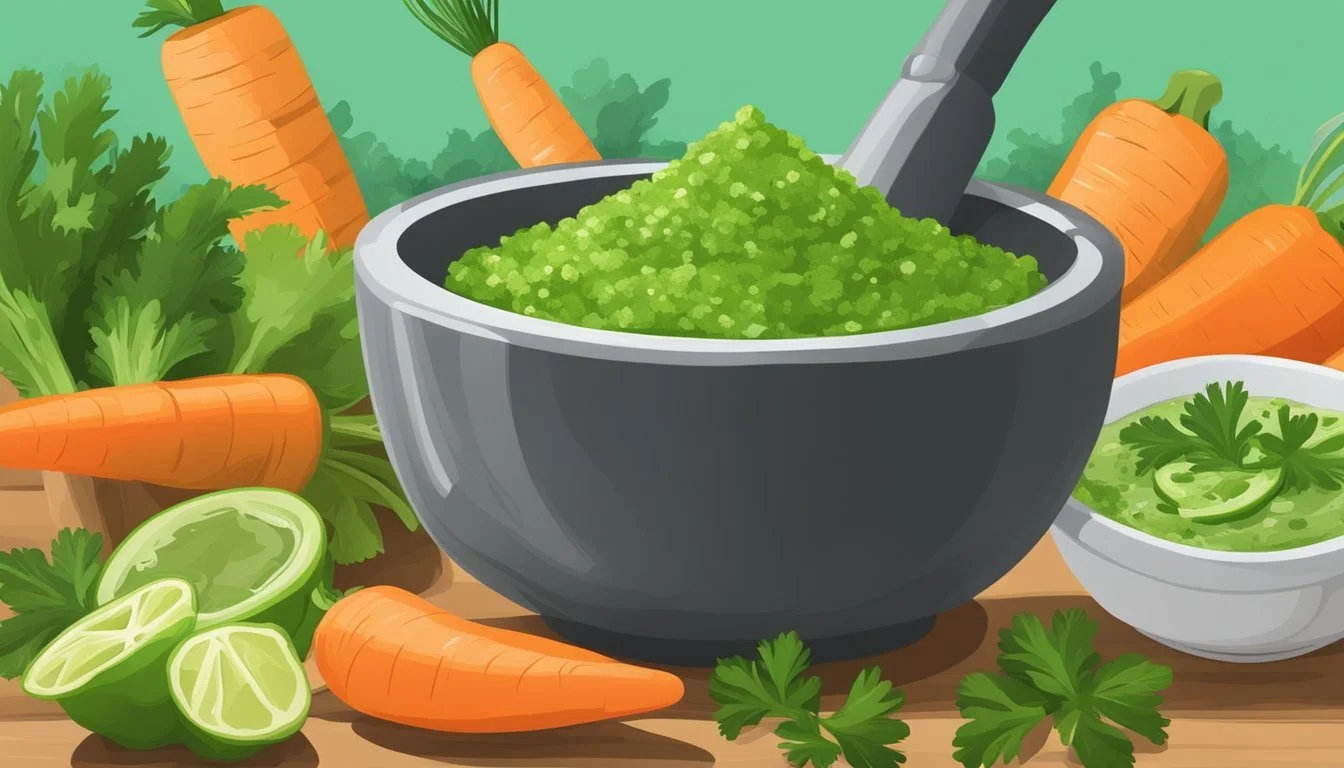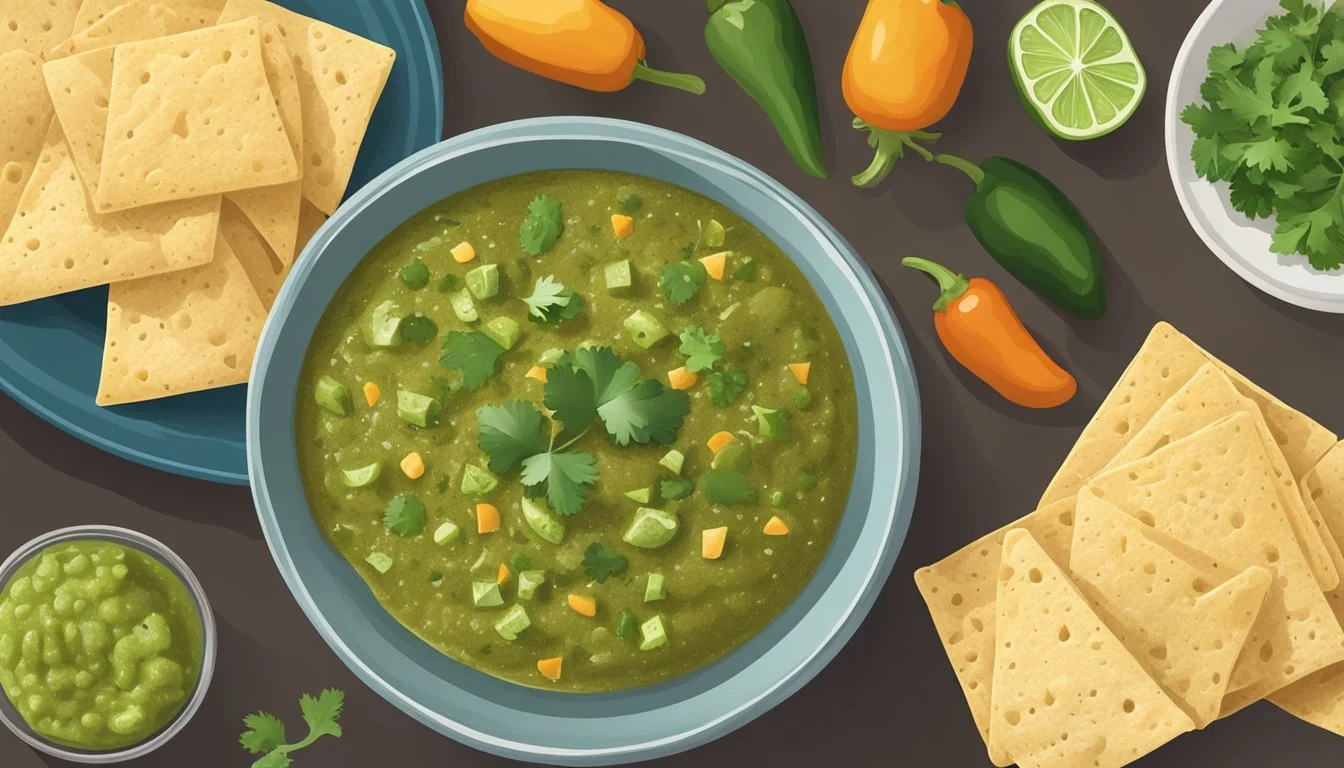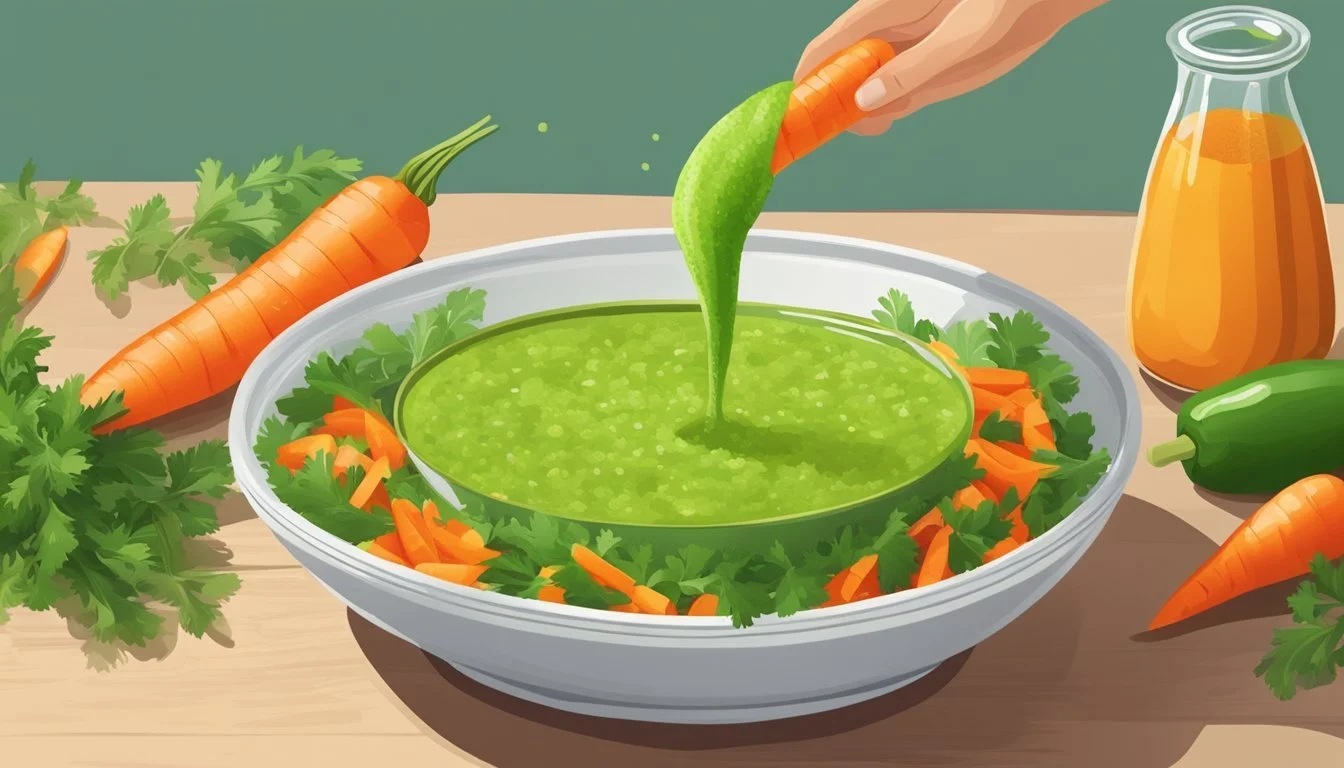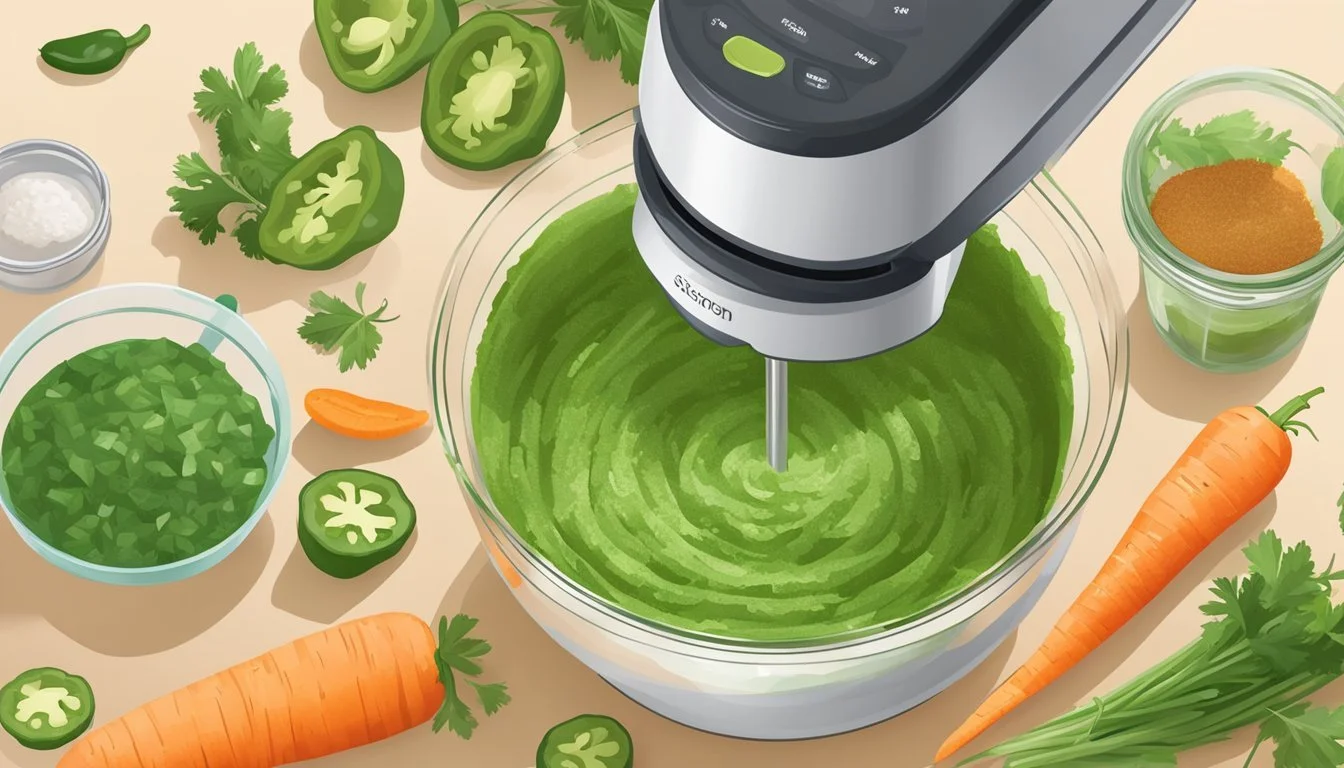Carrot Top Salsa Verde
Elevating Flavors with a Zesty Twist
Carrot top salsa verde is a vibrant and zesty sauce that elegantly transforms the often-discarded green tops of carrots into a culinary centerpiece. Its foundation rests on the principles of sustainable cooking, an approach that emphasizes the use of the whole vegetable. By salvaging the leafy greens, this sauce offers a unique combination of flavors while reducing food waste. Its earthy undertones and slightly bitter notes are enlivened with the addition of fresh herbs, garlic, and citrus, creating a condiment that is as versatile as it is flavorful.
The preparation of carrot top salsa verde requires minimal effort, yet the result is a bright sauce that introduces a spicy kick to numerous dishes. The sauce pairs seamlessly with various recipes, enhancing everything from roasted vegetables (What wine goes well with roasted vegetables?) to grilled meats, and offers a fresh alternative to traditional dips and spreads. The spicy aspect can be adjusted according to personal preference, allowing for a customized heat level that complements the freshness of the carrot tops and herbs.
While its color is reminiscent of a classic salsa verde, the use of carrot tops pays homage to both the ingenuity of home chefs and the creativity of professional kitchens. This sauce stands out as a robust addition to any cook's repertoire, encouraging culinary exploration and an appreciation for the versatility of all parts of an ingredient. With its discernable flavor profile and commitment to sustainability, carrot top salsa verde is poised to become a staple for environmentally conscious gourmands.
History and Origins
Salsa Verde, meaning 'green sauce', has a multifaceted history, with variations found in diverse cultures. In Mexico, the Mexican salsa verde traces back to the Aztec Empire. This sauce usually incorporates tomatillos, green chili peppers, cilantro, and sometimes lime juice, offering a tangy and spicy flavor profile integral to Mexican cuisine.
On the other hand, the Italian counterpart, Italian salsa verde, differs significantly from the Mexican version. It is a cold condiment, including ingredients like Italian parsley, capers, (What wine goes well with capers?) anchovies, (What wine goes well with anchovies?) garlic, and olive oil. In Italy, this sauce frequently accompanies meats and fish, and its use has been documented in various European cuisines since medieval times.
While not directly related to salsa verde, Pesto and Chimichurri are similar in the sense of being green sauces used to enhance dishes. Pesto, originating from Genoa in the Liguria region of Italy, primarily combines basil, pine nuts, Parmigiano-Reggiano, garlic, and olive oil. In contrast, Chimichurri, hailing from Argentina and Uruguay, is a green sauce majorly made with parsley, garlic, vinegar, and oil.
Although not necessarily green, Carrot Top Salsa Verde is a modern take on green sauces using the green foliage of carrots, which are often discarded. Reflecting a contemporary push towards zero-waste cooking, it includes ingredients such as carrot tops, mint, capers, garlic, and olive oil, emphasizing a sustainable and flavorful use of all parts of the carrot.
Each variant of salsa verde corresponds with the distinct ingredients and culinary practices of its culture, illustrating how a simple concept of a green sauce can diversify and adapt over time and across geographies.
Nutritional Benefits
Carrot Top Salsa Verde not only adds vibrant flavor to dishes but also comes with an array of nutritional benefits. The greens used in the salsa, notably the carrot tops, are rich in vitamins and minerals. They are a good source of vitamin C, which is vital for immune system function and acts as an antioxidant.
The addition of olive oil provides healthy fats, mainly monounsaturated fats, which are known to support heart health. Olive oil also enhances the absorption of vitamin A, present in the greens, vital for vision and immune functions.
Table: Key Nutritional Components in Carrot Top Salsa Verde
Nutrient Benefit Vitamin C Supports the immune system Calcium Critical for bone health Potassium Regulates fluid balance in cells Dietary Fiber Aids in digestion
Regular consumption of carrot tops can contribute to the intake of calcium and potassium, both essential minerals for maintaining strong bones and proper cellular functions, respectively.
In addition, the fresh herbs and ingredients like garlic and lemon not only infuse the salsa with bold flavors but also pack in additional vitamins and bioactive compounds that may provide anti-inflammatory benefits.
This sauce can be a healthful addition to a well-balanced diet, offering a blend of nutrients that contribute to overall well-being.
Selecting Ingredients
Creating Carrot Top Salsa Verde begins with careful selection of fresh and quality ingredients. The brightness of the sauce hinges on the freshness of the greens, while its boldness is a balance struck by the combination of oils, acids, and a well-considered mix of herbs and spices.
Choosing the Best Carrot Tops
When looking for fresh carrot tops, seek out vibrant green coloring and sprightly leaves, which are indicative of their freshness. It's vital to rinse them thoroughly to remove any residual dirt, as this imparts a clean flavor to your salsa verde.
Carrots and Root Vegetables Varieties
Although the tops are the star, the carrots themselves should not be overlooked. Root vegetables can vary in sweetness and earthiness, from traditional orange carrots to more unique purple or white varieties, which can subtly influence the overall flavor profile of the salsa.
Oils and Acids
For the oil component, extra virgin olive oil is preferred for its fruity notes and ability to carry the flavors of other ingredients. In salsa verde, acidity is pivotal — a balance of vinegar and lemon juice provides a bright sharpness that elevates the sauce. One can opt for sea salt or kosher salt to season, with the latter being preferred for its clean, non-metallic taste.
Herbs and Spices
The selection of herbs and spices defines the salsa verde's character. Parsley and cilantro provide a fresh base, while mint adds a refreshing undertone. For heat, red pepper flakes are commonly employed. Garlic adds depth, and freshly ground pepper gives a piquant edge to the sauce. The use of dried oregano can impart an earthy note, contributing to the sauce's complexity.
Preparation Techniques
In crafting Carrot Top Salsa Verde, specific preparation methods are critical for achieving the vibrant flavor and texture that sets this sauce apart.
Washing and Preparing Carrot Tops
To begin, one must ensure the carrot tops are thoroughly cleaned to remove any dirt. They should be immersed in a sink full of water, swished around to loosen soil, and rinsed until the water is clear. Once clean, the carrot tops can be dried with paper towels or spun in a salad spinner. A vegetable peeler may be required to remove any tough stems before the tops are finely chopped to aid in the blending process.
Creating the Base
Carrot tops form the foundation of the salsa verde. A good base includes ingredients such as fresh Italian parsley, garlic, and red pepper flakes for added heat. These are typically combined in a bowl with capers and the zest and juice of a lemon. At this stage, extra virgin olive oil is also stirred in to create an emulsion which brings together the flavors. This is an essential step before blending.
Blending for Perfect Texture
To achieve a smooth consistency, the base mixture is then transferred to a food processor or blender. The device should be of high quality to create a fine purée. It may be necessary to add additional olive oil during blending to reach the desired texture. The sauce is blended until all components are well-incorporated, ensuring a uniform consistency that is neither too chunky nor too runny.
Recipe Variations and Styles
Carrot Top Salsa Verde is versatile, allowing for numerous flavorful twists. Chefs can easily alter the base recipe to align with their desired palate, whether it's adding a smoky note or upping the zestiness.
Classic Carrot Top Salsa Verde
The traditional style involves finely chopping the bright green carrot tops and combining them with ingredients like Italian parsley and extra virgin olive oil. Variations may include a balance of acidity from white wine vinegar and a hint of umami from anchovy paste.
Roasted Flavor Twist
Incorporating roasted carrots into the salsa adds a sweet, caramelized dimension that pairs beautifully with the herbaceous carrot tops. One could sprinkle in pumpkin seeds for a nutty crunch, enhancing both texture and flavor.
Zesty Citrus Infusion
A burst of citrus can transform the salsa, infusing it with a refreshing tang. The zest and juice from a lemon not only heighten the taste but also act as a natural preservative. Some may choose to exclusively use lemon zest, while others might experiment with a range of citrus flavors.
Spicy and Bold
To elevate the salsa’s heat level, one could add sliced chili peppers or a dash of red pepper flakes. The spiciness should complement, not overwhelm, the salsa’s garden-fresh taste. Ingredients like red wine vinegar may be used to balance and round out the strong, bold flavors.
Serving and Pairing Suggestions
Carrot Top Salsa Verde, with its bright and spicy flavor profile, transforms ordinary dishes into gourmet experiences. This versatile sauce can be paired with a variety of foods, elevating the taste of proteins, vegetables, and starches.
Proteins and Main Dishes
Grilled Meat: A spoonful of Carrot Top Salsa Verde over grilled steak brings out the richness of the meat.
Chicken: Drizzling the salsa over roasted or grilled chicken adds a zesty twist to the classic dish.
Vegetables and Sides
Roasted Vegetables: Mix Carrot Top Salsa Verde with an array of roasted vegetables for an herbaceous kick.
Potatoes: Toss roasted potato wedges in the salsa for a flavorful side dish.
Breads and Starches
Bread: Serve the salsa as a bold dipping sauce alongside a crusty bread.
Starches: Enhance the humble side dish of rice or quinoa by swirling in some of the vibrant salsa.
Storing and Preservation
Proper storage techniques ensure that Carrot Top Salsa Verde maintains its bright flavor and texture. Whether for short-term enjoyment or long-term use, effective preservation methods can maximize the salsa's shelf life and reduce food waste.
Short-Term Storage
For those looking to savor the salsa within a few days, refrigeration is key. Carrot Top Salsa Verde should be placed in an airtight container and can be stored in the refrigerator for up to 5 days. To retain freshness, they should ensure the container is sealed tightly after each use, as this minimizes air exposure and potential spoilage.
Long-Term Preserve
For extended preservation, one can consider freezing Carrot Top Salsa Verde or incorporating it into a brine. When freezing, the salsa should be portioned into usable amounts and stored in freezer-safe containers or bags, with air pressed out to prevent freezer burn. In brine form, the salsa can be merged with a mixture of vinegar, salt, and sugar, enhancing its longevity and adding a pickled twist that pairs well with dishes like BBQ meats. It's also an excellent complement to creamy bases like labneh or yogurt, where its flavors can infuse over time.
Dealing with Leftovers
Leftovers present an opportunity for creativity. Excess Carrot Top Salsa Verde can be transformed into a vibrant dressing for salads or a zesty marinade for grilled vegetables (What wine goes well with grilled vegetables?) and proteins. For a simple yet impactful use, one might add a spoonful to elevate the taste of a plain labneh or yogurt bowl. If the leftover quantity is substantial, it can also be shared at a communal meal, such as a BBQ, where its bright and spicy notes can be appreciated by a larger audience.
Health Considerations
When preparing Carrot Top Salsa Verde, individuals should be aware of its health aspects. Since the sauce predominantly features carrot tops and a variety of herbs, it is inherently vegan and gluten-free, making it suitable for those on stricter diets. However, there might be variations in recipes that introduce non-vegan or gluten-containing ingredients.
For those with allergies, it is important to note common allergens that could be present in the salsa:
Garlic and capers: While not common allergens, some individuals may have sensitivities to these ingredients.
Extra virgin olive oil: Generally safe, but quality and processing could affect allergenic properties.
It is important for individuals with severe allergies to review each ingredient and ensure that cross-contamination is avoided during the preparation process. Here is an overview of the typical core ingredients:
Carrot tops: Nutrient-dense, containing vitamins, minerals, and fiber
Herbs (parsley, basil, mint): Rich in antioxidants
Olive oil: High in monounsaturated fats, particularly oleic acid
Lemon juice: Vitamin C and flavor without the need for additional salt
Carrot Top Salsa Verde has the potential to provide a healthy addition to a meal due to its fresh ingredients that offer a range of nutrients and health benefits. However, those interested in its preparation should tailor the recipe to their dietary needs and allergy concerns.
Cooking Tips and Tricks
When embarking on the creation of Carrot Top Salsa Verde, a cook should be attentive to preparation and blend of flavors. Here are some tips and tricks:
Prep Time: Efficiently prepping vegetables can drastically reduce the total time required. Carrot tops should be thoroughly cleaned to remove any dirt before use. Swishing the tops in water usually helps the dirt to settle at the bottom.
Herbs: Incorporating Italian parsley or fresh basil can enhance the sauce's fragrance and depth. Herbs should be finely chopped to release their essential oils.
Oil & Cheese: Extra virgin olive oil is a favored choice for its fruity notes, while a sparing addition of finely grated parmesan can impart a savory umami flavor.
For a vivid sauce, chefs advocate using fresh ingredients. Here’s a simplified guideline to follow:
Ingredient Preparation Carrot Tops Clean, dry, finely chop Herbs Fresh, finely chop Parmesan Grated Vegetables Optional for serving, as preferred
Vegetables & Complements: Beyond the main ingredients, consider pairing the salsa verde with roasted radishes or beets to highlight the sauce’s bright profile.
By following these concise tips, cooks can skillfully prepare Carrot Top Salsa Verde, with a total time likely under 30 minutes, depending on the dish's complexity and additional components. They should aim for balance in flavor and texture to produce a sauce that delights the palate.
Conclusion
Carrot top salsa verde is a vibrant, zesty sauce that adds an unparalleled freshness to a variety of dishes. Characterized by its green hue and peppery undertones, it is an excellent way to utilize the often-discarded greens of carrots. Chefs and home cooks alike find this sauce to be a perfect companion for summer meals, providing a bright touch to outdoor grilling or light, warm-weather dishes.
With its rich umami flavor, carrot top salsa verde caters to those seeking depth in their culinary creations without overshadowing the primary ingredients. The sauce's complex profile—with notes of herbs, acidity, and mild heat—is loved for its versatility. Here are some quick highlights:
Seasonal Appeal: It shines during summer but is not limited to any season.
For Everyone: Beginners and experts can both appreciate its straightforward recipe.
Umami Depth: Enhances dishes with a savory, satisfying essence.
Ultimately, they treasure carrot top salsa verde for its sustainable twist on traditional sauces, as well as its ability to elevate the simplest of meals to something memorable. Its creation, rooted in the principle of kitchen resourcefulness, champions utilizing all parts of produce. The result is a sauce that delights the palate while aligning with thoughtful food practices.









